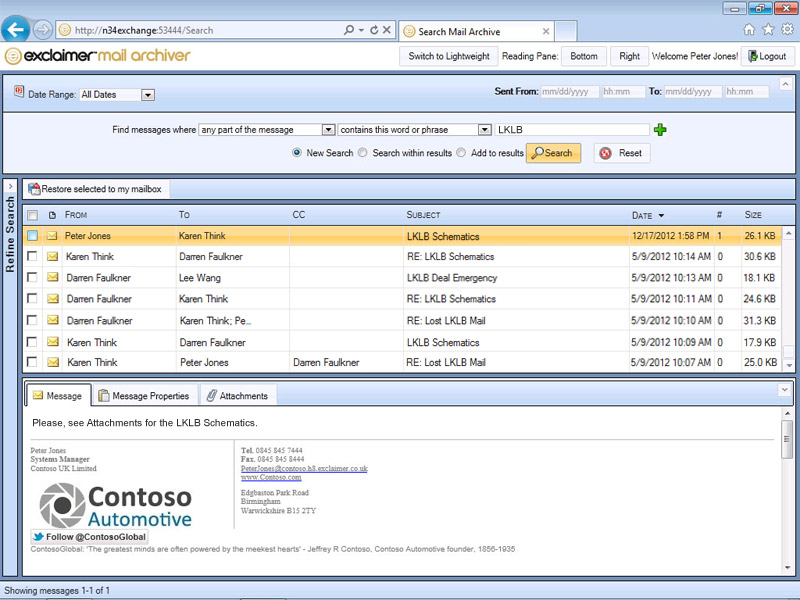
This cookie is set by GDPR Cookie Consent plugin. The cookies is used to store the user consent for the cookies in the category "Necessary". The cookie is set by GDPR cookie consent to record the user consent for the cookies in the category "Functional". The cookie is used to store the user consent for the cookies in the category "Analytics". These cookies ensure basic functionalities and security features of the website, anonymously.
YAHOO MAIL ARCHIVER DOWNLOAD
The current lag time from requesting the data to being able to download it is about a week at the time of writing.Necessary cookies are absolutely essential for the website to function properly. Methods that scrape the API from a non-moderator/owner(?) account will have email addresses in the message contentsĭownsides to using this tool are that not all group content is returned, even for group owners!
YAHOO MAIL ARCHIVER ARCHIVE
The primary benefit to using the Yahoo tool is for retrieving the full, unredacted email archive for a group. No further data is returned, even if you are group owner. photos and attachments you sent/uploaded to the group.mbox format, with all addresses unredacted Yahoo have a "Get My Data" tool for downloading content of groups of which you Alternatives to this tool Yahoo Get My Data
YAHOO MAIL ARCHIVER SOFTWARE
We're not responsible for third party software like Yahoo Group Archive Tools, so to be safe, please retain the original output of this tool. Once a list is imported into one of these clients, it may be possible to export the list content into other formats, like printing to PDF. Mail folders stored as mbox can be imported by a wide range of desktop and server-side email clients, including Thunderbird (Linux, Mac, Windows), Apple Mail.app (Mac), Microsoft Outlook (Windows and Mac) in some cases, users will need to use an external utility. The Yahoo Group Archive Tools software takes the output of this archive, and convert it into mbox format, as well as individual email files.

But this can be hard for people-and particularly non-technical people-to read. This tool saves a complete archive of a Yahoo Group in Yahoo Groups API's custom JSON format. w, -warc Output WARC file of raw network requests. Last message ID available, if start option provided. stop STOP Email message id to stop at (inclusive), defaults to start START Email message id to start from (specifying this willĬause only specified message contents to beĭownloaded, and not message indexes).

Note: These options will also try to fetch message IDs Options to specify which messages to download. Override the default user agent used to make requests o, -overwrite Overwrite existing files such as email and database a, -about Only archive general info about the group r, -raw Only archive raw email without attachments through the t, -topics Only archive HTML email and attachments through the at, -attachments Only archive attachments (from attachments list) e, -email Only archive html and raw email and attachments (from Passed on the command line will overwrite any already cf COOKIE_FILE, -cookie-file COOKIE_FILEįile to store authentication cookies to. delay DELAY Minimum delay between requests (default 0.2s)Īdditional EuConsent cookie is required in EU colour, -color Colour log output to terminal h, -help show this help message and exit Using the -cookie-file (or -cf) option allows you to specify a file in which the authentication cookies will beįiles will be placed into the directory structure groupname/ Command Line Options Note: the string you paste must be surrounded by quotes. Double click on the Y cookie's value and copy the content in place of in the above command line.Double click on the T cookie's value and copy the content in place of in the above command line.Press Shift-F9 or select the menu Tools/Web Developer/Storage Inspector.Go to Yahoo Groups (make sure you're signed in with your account).Select the Y cookie, right click the value in the Content field and Select All.Select the T cookie, right click the value in the Content field and Select All.On the Allowed tab select "" followed by "Cookies" in the tree listing.Click the 🔒 padlock, or ⓘ (cicled letter i) in the address bar to the left of the website address.

In Google Chrome these steps are required: Y: v=1&n=someLongText&l=someShortText=someShortText&r=hp&intl=us.T: z=someLongText&a=someLongText&sk=someLongText&ks=someLongText&kt=someLongText&ku=someLongText&d=someLongText&af=someLongText.The cookies should look like this, where someLongText and someShortText are arbitrary strings:

You will need to get the T and Y cookie values from an authenticated


 0 kommentar(er)
0 kommentar(er)
